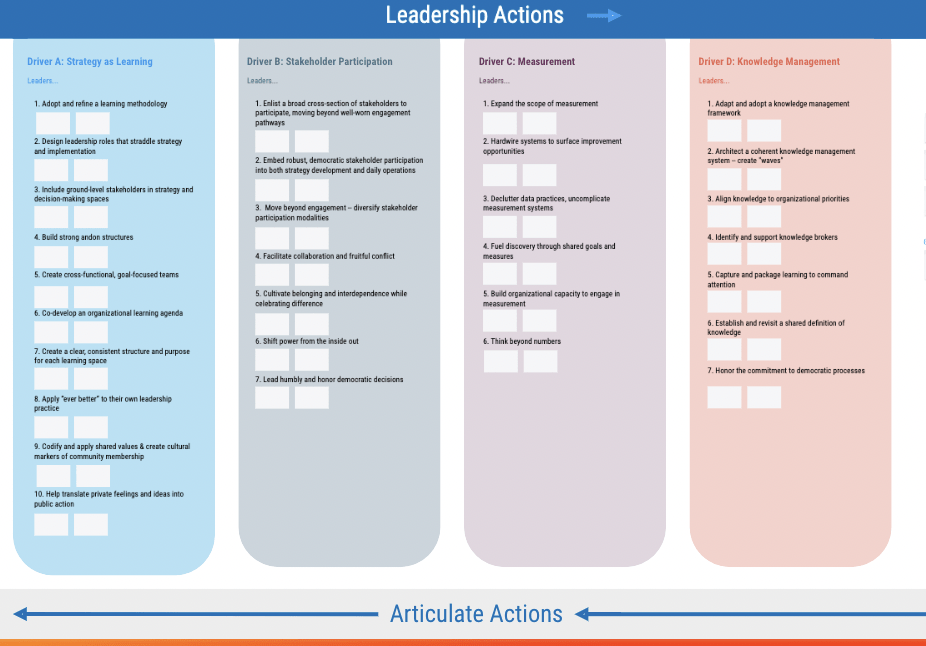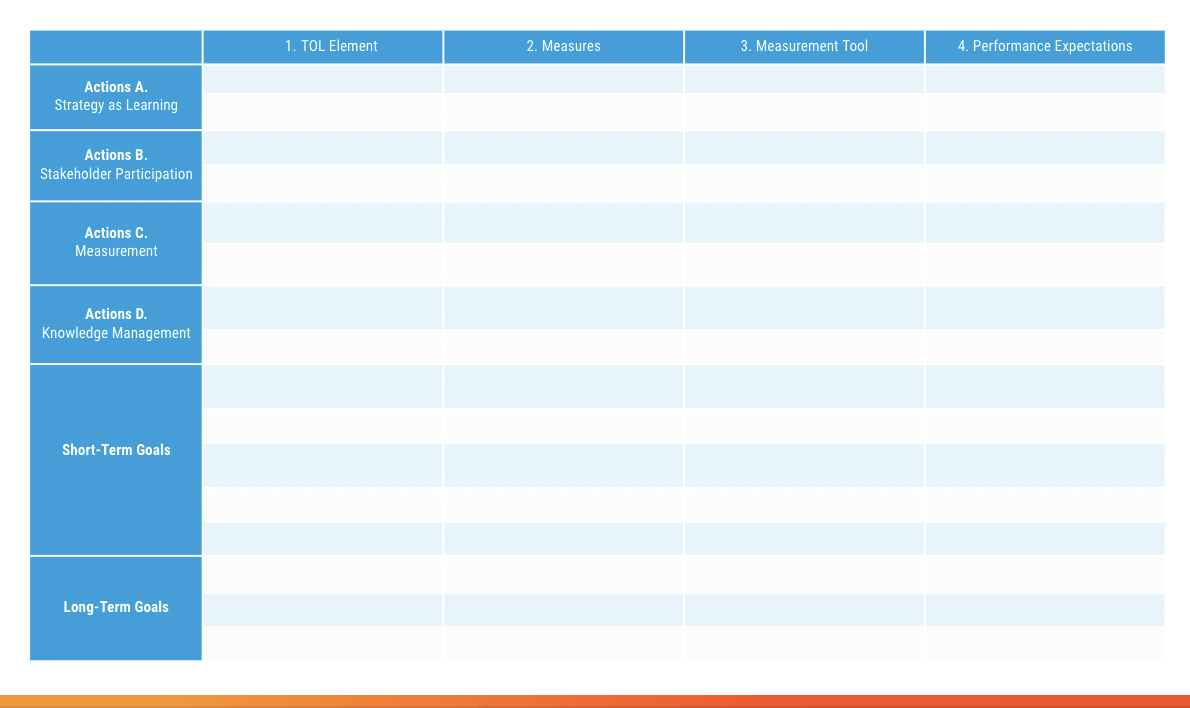Determine measures for your Theory
Timing - 2 Hours
In this activity, you will craft a list of measures to track the implementation and success of your approach.
Back to Phase 3 overviewOverview
With a version of your Theory ready for implementation, develop a list of measures, tools, and performance expectations to help monitor the impact of your approach. Ideally, you would have the opportunity to measure each action and goal articulated in your Theory, but such an ambitious monitoring agenda is typically impractical.
Instead, use this protocol to select a representative subset of impacts, outcomes, and actions to track.
Let’s get started.
Tools & Materials

Completed Theory of Leadership
Suggested Preparation
Collect a list of the types of data your system might already routinely collect (e.g., staff surveys) to begin your assessment of what additional measurement tools you might need to measure success.
Need support? Learn more about working with CPRL.
Protocol
As a group, review your Theory of Leadership and identify the outcomes, actions, and impacts you will measure.
As you identify elements you would like to measure, enter them into Column 1 of the TOL Measurement activity template.
As you select goals, actions, and impacts, consider whether you are measuring elements of your approach that are:
- Focused on equity. Have you identified elements that will measure how your approach is affecting the most marginalized groups in your system or that are essential to advancing equitable outcomes?
- Critical to its success. Are you measuring the actions and short-term goals that are most essential to achieving your long-term goals?
- Both process and outcome measures. Are you measuring elements of your approach that will provide you with both (a) leading process measures of progress (e.g., measures aligned to inputs and actions?) and (b) lagging outcome measures of success (e.g., measures aligned to short- and long-term goals)?
- In aggregate, representative of your full strategy. Have you selected actions that span the four Playbook drivers? Short-, mid-, and long-term goals?
- Providing the clearest signal that you are on track. Have you identified goals that can be measured more quickly, therefore providing strong early signs of the efficacy of new leadership actions or that are building blocks for mid-term goals?
- New to leaders or a known area of weakness. Have you prioritized measuring actions and goals that you have coded in yellow and red?
- Easy to measure or are already being measured. Are you measuring Theory elements that are relatively easy to observe or evaluate or that you already measure for other parts of your work?
Develop measures for the outcomes, actions, and impacts you’ve selected.
Determine whether to measure each element’s quality, quantity, or both, then capture and revise measures in Column 2 of your measurement template.
Aim for measures that:
- are tightly aligned to what they are measuring, coming as close to the desired processes and outcomes as possible, recognizing that almost all measures are only proxies, to some degree.
- are feasible to implement—select measures you can easily track or that you are already monitoring.
- are capable of consistently and accurately revealing variation (a) in quality or quantity of implementation and results and (b) between expectations and what actually happened.
- Let you monitor disparities by race, ethnicity, and other identifiable categories.
Also consider whether you will include balancing measures.
- Balancing measures indicate whether elements of your leadership approach are causing new and unanticipated problems for your broader organization. Focusing improvement on one area of a system may produce unintended effects in another area. For example, increasing the number of collaborative learning spaces in your system might unintentionally affect the degree to which ground-level staff feel they’re able to commit to personalized student support.
It’s helpful, therefore, to consider how elements of your approach may affect other important activities and resources and to identify ways of measuring those effects so you can appropriately revise your Theory to mitigate or reduce any negative impacts you observe.
Select your measurement tools.
With measures tentatively selected, select appropriate measurement tools. Tools you may consider using include surveys, administrative records, standardized assessments, and observation rubrics.
As you select tools for each of your selected measures, record them in Column 3 of your template.
As possible, select tools that are already in use in your system, keeping in mind that you may need to seek input from individuals outside your improvement team to get a full sense of available tools.
Set performance expectations.
To understand whether your Theory is working as planned, set performance expectations for each measure you’ve selected. Strong performance expectations will let you quickly identify where your approach is falling short and where to intervene.
To ensure that your performance expectations serve these purposes, be sure they:
- Define success. Set expectations at a level that you consider to be fully satisfactory yet realistic. They should reflect what you expect to observe if your approach works as planned.
- Reveal how equitably you are implementing your initiative and how equitable its impact is. Be explicit about how you expect your approach to affect historically marginalized people. Set success at a level that increases equity and corrects processes or activities that reproduce injustice or oppression.
- Motivate action. Performance expectations should be specific enough to give people a clear view of what they’re aiming to do or accomplish. To inspire people to act, performance expectations must also be realistic to achieve. If they are not, they may not be taken seriously and may cause frustration.
- Clarify progress. Select performance expectations that align to your performance measures, and clearly reveal whether the actual level or quality of actions and results is at, below, or above what you expect.
There are three main sources you may draw upon in setting performance expectations:
- Directives are official regulations set by your system or organization or outside it that prescribe performance expectations. You can use the directives as your performance expectations when there are required results you are expected to meet. Be sure to consider, however, whether the regulation levels prescribed are sufficiently rigorous and realistic.
- Often your own best judgment about what success looks like is the best guide to rigorous and realistic performance expectations, especially when there are no relevant directives for a measure and when team members have relevant expertise or experience.
- Benchmarking uses your own team’s or another organization’s past performance levels in the same or a similar context as a point of reference in setting expectations for your measures. If information about such performance levels is available to you, benchmarking can be particularly useful. If you have no other directives or reliable judgments to draw upon, they can also help you determine whether directives and your own judgments are sufficiently rigorous and realistic. Keep in mind that performance expectations may need to change over time. As you learn more about your approach and capabilities, revisit your expectations.

